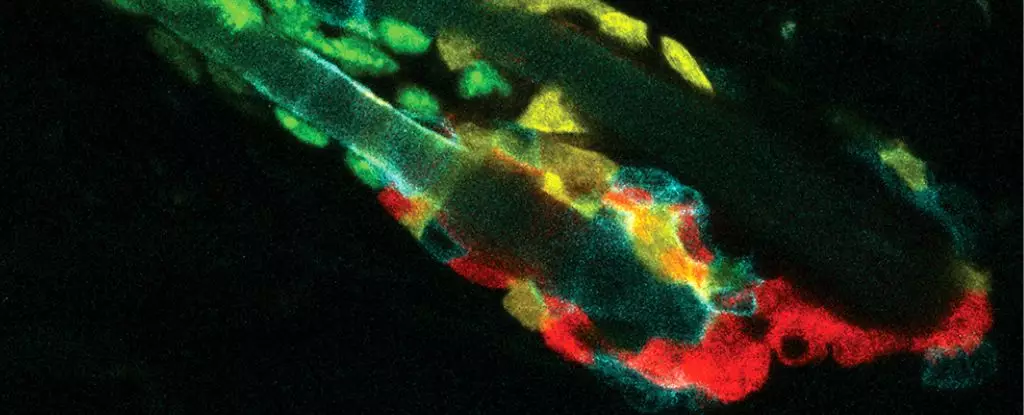The human body is a complex system of intricate processes, continually at work to maintain homeostasis and health. One lesser-known aspect of this biological machinery is the inevitable death of cells—a reality that occurs at an astonishing rate of approximately one million cells per second. While our body brilliantly manages countless processes, a recent study has revealed a sophisticated mechanism for dealing with cellular waste that demonstrates surprising efficiency and cooperation among cells.
The Cannibalistic Cleanup Explained
In a groundbreaking study led by researchers at Rockefeller University, scientists uncovered a fascinating cleanup process involving living stem cells that consume their dead neighbors in the hair follicles of aging mice. This discovery, rather than supporting a survival of the fittest narrative, highlights a cooperative and almost cannibalistic aspect of cellular life. Katherine Stewart, a cellular biologist, articulated how this mechanism operates, emphasizing that the living stem cells depend on two finely attuned receptors to respond to signals from dying cells. These receptors essentially allow the healthy cells to be “recruited” by the scent of death, facilitating a rapid response to maintain the health of the cellular community.
Stewart described the system as remarkably elegant, stating, “If one of them disappears, the mechanism stops operating.” This precision safeguards against unnecessary consumption of healthy cells, allowing the cleanup process to focus solely on nearby corpses. The study not only highlights the ability of hair follicle stem cells to respond to death but also suggests a broader significance in managing cellular turnover across various tissues in mammals.
The research primarily focused on the late-stage hair follicles of mice, where distinct observations were made regarding the role of hair follicle stem cells (HFSCs) during the cell death process. Contrary to expectations that immune cells, such as macrophages, would initiate cleanup, it was revealed that HFSCs are the first responders in this cellular graveyard scenario. This finding was particularly striking for Stewart and her team, given that a substantial population of macrophages resides nearby, ready to assist in the cleanup process.
Through meticulous experiments, it became clear that when HFSCs began to die, their neighboring cells wasted no time and quickly engulfed these dying cells. This self-consumption appears to limit the potential inflammatory responses typically brought about by immune cells, hence protecting the stem cell population from an overactive immune reaction. In cases where this self-cleanup mechanism falters, the remnants disrupt the maintenance of the stem cell reservoir, leading to potential long-term deficits in cellular regeneration.
Furthermore, the consumption of deceased neighbors could serve as a means of recycling cellular materials for energy purposes, as pointed out by Elaine Fuchs, a noted figure within the Rockefeller lab. She highlights the necessity for HFSCs to swiftly return to their primary responsibilities after the removal of corpses—maintaining the hair follicle’s structure and function.
A Two-Prong Signaling System
At the heart of this cellular cooperation is a finely honed signaling pathway involving two specific receptors that function essentially as ‘ON’ and ‘OFF’ switches. The process is initiated when these receptors detect unique signals from dying cells. One receptor is designed to recognize a “find me” lipid signal emitted by a cell in distress, while the other receptor is triggered by growth-promoting retinoic acid from healthy cells. This dual-reception strategy ensures that the cleanup process is both responsive to immediate crises and balanced to promote cellular growth and function when required.
As Stewart elucidates, this finely tuned mechanism operates swiftly—once there are no dead cells left, the lipid signal fades, allowing healthy cell signaling to dominate. This seamless transition demonstrates not just a remarkable efficiency but also an overall intelligence in cellular behavior.
The findings from this study raise intriguing questions about the universal applicability of this cleanup mechanism across other tissues in mammals. While the focus has been primarily on hair follicles, the researchers speculate that this cannibalistic behavior could extend to various cellular environments, warranting further investigations.
Understanding such cellular dynamics not only deepens our comprehension of fundamental biological processes but may also uncover novel therapeutic pathways for addressing diseases characterized by dysfunctional cellular turnover or improper inflammation. The innate ability of cells to manage their local environment reflects profound biological wisdom—one that remains a vivid reminder of the complexity and beauty of life at the cellular level.

